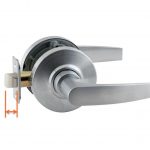 A couple of weeks ago, I wrote a post about a proposed change to NFPA 101 – The Life Safety Code, which would allow existing classroom doors to have hardware that required 2 operations to release the latch, instead of the 1 operation that is currently required. I’m working on a couple of articles about this topic, and during my research I found some things that really surprised me.
A couple of weeks ago, I wrote a post about a proposed change to NFPA 101 – The Life Safety Code, which would allow existing classroom doors to have hardware that required 2 operations to release the latch, instead of the 1 operation that is currently required. I’m working on a couple of articles about this topic, and during my research I found some things that really surprised me.
To give a little background…there are 6 NFPA 101 change proposals in the works that affect classroom security – 3 for new occupancies and 3 for existing buildings. The proposals for the new occupancy chapters are consistent with the changes that will be included in the 2018 editions of the International Building Code and the International Fire Code, but the proposed changes for the existing occupancy chapters would allow 2 operations to release the latch instead of 1. While this may not seem like a big deal, it’s a major change from past editions of NFPA 101, and is inconsistent with other codes and standards.
~~~ Surprise #1 ~~~
There are 3 occupancy chapters where this language regarding 2 operations would be inserted: Chapter 15 – Existing Educational Occupancies, Chapter 17 – Existing Day Care Occupancies, and Chapter 39 – Existing Business Occupancies (see pages 31, 36, and 79 of this document). Many college and university classroom buildings are considered business occupancies, so the proposal for Chapter 39 would cover these facilities. BUT – the proposal for this chapter does not reference classrooms or colleges/universities, so the language could actually be applied to any room in any business occupancy – where approved by the Authority Having Jurisdiction. We have already seen AHJs being pressured to allow security devices that are not compliant with the model codes; this is a difficult position for any code official.
The current and past editions of NFPA 101 allow 2 releasing operations for residential dwelling units and for existing hardware on rooms with an occupant load of 3 people or less. In these locations, the occupants are likely to be familiar with locking/unlocking the door and the risk is low. What is the justification to go from these limited exceptions to allowing 2 operations for all classroom doors and any approved doors in a business occupancy?
~~~ Surprise #2 ~~~
The various chapters of NFPA 101 are the responsibility of different technical committees. The committees that are considering approval of the classroom-related changes are made up of different members than the Technical Committee on Means of Egress. When Chapter 7 – Means of Egress states a requirement, and one or more occupancy chapters include an exception to that requirement, language must be added to Chapter 7 referencing these exceptions. When a proposal was made to add a reference in Chapter 7 to the exceptions for 2 operations, the Technical Committee on Means of Egress almost unanimously opposed this change (see page 6 of 13 in this report).
The technical committee made this statement: “It is the position of the TC on Means of Egress that increasing the number of latch/lock releasing operations is dangerous and could create a hazard to occupants. Technology exists that will meet the current code requirement for not more than one latch/lock releasing operation. The need for multiple operations is contrary to decades of experience resulting in fatalities in schools and other buildings. Single-action egress is an important aspect of life safety for all emergencies.”
~~~
This proposal will be discussed at NFPA’s technical meeting in June, and will be voted on by the eligible members. I hope the voters will carefully consider this change and the inconsistencies that will be created if it is approved, as well as the historical basis for the requirement for a single releasing operation.
You need to login or register to bookmark/favorite this content.





Lori, I find it hard to believe that no human subject testing is being conducted before considering changing anything. Allowing something so far beyond the pale- without studying human response to stress- is unconscionable in the use of these devices. Several assumptions are being made without considering most people are unable to perform anything closely resembling one fine motor skill under stress. Requiring them to do two is probably beyond 90-95% of the people I see in training. Maybe even higher than that. LE misses 70-80% of rounds fired under stress situations. The mistakes we made with lockdown are being acerbated by the push for these devices.
Specifically, what is the NFPA’s reasons for allowing a two-step unlocking?
I really wish I knew.
– Lori
I’ve always wondered about the 2-operation thing for dwelling units–I’ve seen plenty with up to four operations required to open the door: release the chain, unlock the deadbolt, unlock the Kwikset shared-spindle knob, and turn the knob.